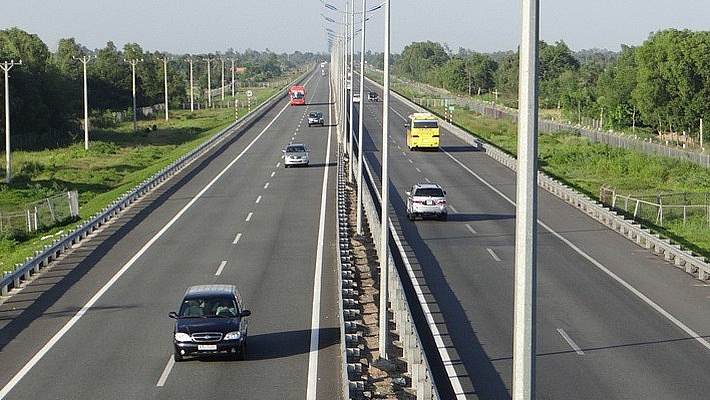Directing FDI into large transport infrastructure projects
 |
| The North-South Expressway is one of the projects that is calling for foreign investors |
Seaport projects pushing ahead
Four months after since the first shipment in May 2018, the construction of the first and second container ports of Haiphong International Port (component B) with the total investment about $321 million has begun, hoping to attract more international shipping lines to the country.
The project is developed by Haiphong International Container Terminal Co., Ltd. (HICT), a joint venture between Saigon New Port, Japan’s Mitsui OSK Lines (MOL), Taiwan’s Wan Hai Lines (WHL), and Japan’s Itochu Corporation (ITO).
Haiphong International Port is the first deep-water port in the key economic region in North Vietnam, which is capable of receiving vessels up to 14,000 TEU and cargo ships up to 160,000 DWT. From this port, the import and export goods from North Vietnam can be directly transferred to Europe, America.
In addition, HICT’s project is only one of the projects attracting investment into port infrastructure, which is the leading segment of the transportation sector in terms of FDI attraction.
Nguyen Ngoc Dong, Deputy Minister of Transport, said that the investment in transportation and seaport management by world-leading corporations such as Hutchinson, PSA, DP World, and SSA has changed the shape of Vietnamese seaports, especially in Cai Mep-Thi Vai Port.
“This is a favourable foundation for Vietnamese seaports to become the link in the global supply chains of maritime corporations and thereby attract more foreign investors to Vietnam,” said Dong.
Beside seaports, another bright spot in FDI transportation attraction is logistics. Even though foreign ownership in the sector is still limited at 49-51 per cent at road, inland shipping, and air transport logistics companies, foreign investors still flock to Vietnam for its attractive trade opportunities.
The presence of foreign investors from Japan, South Korea, and Denmark in large logistics joint ventures is one of the key factors behind the improvement of the Logistics Performance Index ( LPI) from 64th out of 160 countries in 2016 to 39th in 2018 (survey of the World Bank).
The general FDI picture
Seaports and logistics are the rare sectors that successfully attract foreign capital into transportation. Sectors that are receiving less FDI include road infrastructure, railways, airports, and inland waterways.
Among these, the sector receiving the least is road infrastructure—an area with huge capital requirements, but mainly invested by state budget and domestic private investors.
According to the MoT, FDI into road development goes through different models, including BOT and PPP projects where foreign investors contribute capital and directly manage and exploit the completed project; where they hold the right to exploit the routes; or where they buyout domestic enterprises to replace them in the project.
| Nguyen Ngoc Dong, Deputy Minister of Transport, said that the investment in transportation and seaport management by world-leading corporations such as Hutchinson, PSA, DP World, and SSA has changed the shape of Vietnamese seaports, especially in Cai Mep-Thi Vai Port. |
Under these three formats, road infrastructure projects in Vietnam have come to the attention of foreign investors.
For example, Nexco (Japan) proposed a Build-Operate-Transfer (BOT) component project of Phap Van-Cau Gie Expressway, while Infrastructure Leasing & Financial Services Limited (IL&FS) from India wants to buy 70 per cent of the Hanoi-Haiphong Expressway BOT project and Vinci (France) offered to buy the rights to collect tolls on Cau Gie-Ninh Binh Expressway.
However, up to now, none of these projects have been awarded a contract.
In the railway sector, some investors from Russia and the Czech Republic proposed to co-operate with state-owned Vietnam Railways (VNR) to set up a joint venture to manufacture locomotives and wagons, but failed due to the limited export volumes.
“Transportation infrastructure projects require large capital, long time to breakeven, while we have no sufficient legal system and incentive policies, which lead to difficulties in attracting FDI,” the leader of the MoT explained.
According to the MoT, this is the bottleneck that needs to be solved to enhance FDI flows to large-scale infrastructure projects, such as the North-South Highway Project that has eight PPP (Public-Private-Partnership) components with a total investment of about $5 billion, the first stage of the $5.45 billion Long Thanh International Airport project, and the $58 billion North-South high-speed railway.
“With the creation of a PPP investment law, the development of a risk-sharing mechanism, the formation of a state support fund, and ensuring transparency are the keys to open up FDI flows into the transport sector,” the leader of the MoT shared.
Not only seaports and logistics, the development of other areas in the transport system still needs the efforts of authorities at all levels, as well as policies to encourage innovation.
What the stars mean:
★ Poor ★ ★ Promising ★★★ Good ★★★★ Very good ★★★★★ Exceptional
 Tag:
Tag:
Related Contents
Latest News
More News
- Interest in renewables drives foreign investment surge (October 10, 2018 | 15:21)
- Bac Giang: building firm FDI foundations of industry and tourism (October 10, 2018 | 13:09)
- Vietnam’s way ahead in foreign investment and economic growth (October 10, 2018 | 11:17)
- FDI into real estate through the roof in Ho Chi Minh City (October 08, 2018 | 12:37)
- ESMO factory granted investment certificate (October 04, 2018 | 17:23)
- VIR awarded merits and medal for outstanding achievements in FDI attraction (October 04, 2018 | 15:36)
- Hong Kong FTA to boost investment (October 04, 2018 | 14:00)
- FDI gives wings to the banking sector (October 04, 2018 | 14:00)
- Numerous billion-dollar projects licensed at FDI conference (October 04, 2018 | 14:00)
- 3,500 representatives join conference on 30 years of FDI attraction (October 04, 2018 | 11:47)























 Mobile Version
Mobile Version